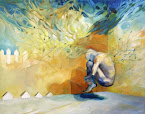Since we read the chapter on cinematography and then discussed its points in class, I feel that I have a much improved understanding and appreciation of the process and the art.
This movie was a good icebreaker in the discussion of the chapter. It broke many rules, but at the same time it set many standards.
When writing a book, the author must establish the characters and establish the plot through dialogue and description. That's all there is to it, right? Wrong. The author must use nuance and tone to convey the ultimate theme of the story as well as to tie up the plot.
When making a movie, the director/cinematographer must establish the characters in the actors and establish the plot through dialogue, image, and sound. That's all there is to it, right? Wrong. The director/cinematographer must use visual/audio nuance and tone to convey the ultimate theme(s) of the story as well as to tie up - or leave untied - the plot. It seems deceivingly simple. When I read the chapter on cinematography, I was amazed at just how much one person's perspective on life matters and translates into the film, and just how much an artistic perspective must be interwoven with technology exactly. If something isn't properly coordinated, it screws up the whole thing.
"Diving Bell" was sort of traditional, at first. There were credits and there was soothing and stereotypically Parisian-type French music. The backgrounds, which were x-rays of the human skeleton seemed to be metaphorical as well as literal - especially the part where it flashes many x-rays at an impossible pace to follow. I felt this also set the tone for the rest of the movie. It was rich with metaphors and second meanings.
The framing was mostly unconventional. For a good part of the movie, the audience sees things through Jean-Do's left eye (his very limited vision). This was incredibly important. Not being able to see certain things, wondering, and being frustrated with the situation put the audience right where he was, and long enough to establish an emotional connection or an understanding. Without this element, the movie could have been as exciting as an artfully done documentary (which can be nice, but it's not something that really impacts a person the way this movie impacted me).
The lighting and color represented a somewhat dreary outlook usually, except for when Jean-Do had flashbacks. The flashbacks were sometimes more vibrant and bright. The lighting was basic. It was pretty dark in the Berck-su-Mer hospital rooms and it was brighter when he was taken outside -pretty realistic.
As far as shots and depth of field go, things in Jean-Do's vision were either very close or considerably far. That, too, was metaphorical. When the movie was in 3rd person view, there was a scene where the depth of field was direct and intensely metaphorical. This was the scene in which Henriette (the speech therapist) and Jean-Do are sitting outside, "talking" and he expressed to her that he had decided to stop feeling sorry for himself. At first it was a long shot of Henriette and Jean-Do and then after he said that he was no longer going to indulge in self-pity, it cut to an extreme long shot. It was simple yet profound.
Sunday, September 20, 2009
Subscribe to:
Post Comments (Atom)

No comments:
Post a Comment